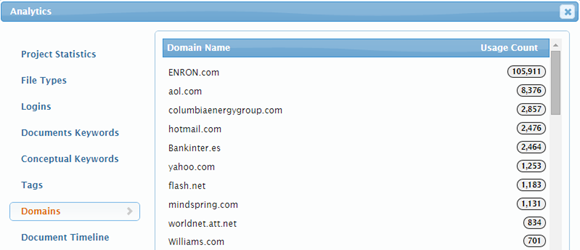eDiscovery Daily Blog
Want to Save Review Costs? Be the Master of Your Domain(s): eDiscovery Best Practices

Yesterday, we discussed how some BigLaw firms mark-up reviewer billing rates two to three times (or more) when billing their clients. But, even if that’s not the case, review is still by far the most expensive phase of eDiscovery. One way to minimize those costs is to identify documents that need little or no review and domain categorization can help in identifying those documents.
Even though the types of electronically stored information (ESI) continue to be more diverse, with social media and other sources of ESI becoming more prominent, email is still generally the biggest component of most ESI collections and each participant in an email communication belongs to a domain associated with the email server that manages their email.
Several review platforms, including (shameless plug warning!) our CloudNine™ platform (see example above using the ever so ubiquitous Enron data set), support domain categorization by providing a list of domains associated with the ESI collection being reviewed, with a count for each domain that appears in emails in the collection. Domain categorization provides several benefits when reviewing your collection by identifying groups of documents, such as:
- Non-Responsive ESI: Let’s face it, even if we cull the collection based on search terms, certain non-responsive documents will get through. For example, if custodians have received fantasy football emails from ESPN.com or weekly business newsletters from Fortune.com and those slip through the search criteria, that can add costs to review clearly non-responsive ESI. Instead, with domain categorization, domains in the list that are obviously non-responsive to the case can be quickly identified and all messages associated with those domains (and their attachments) can be “group-tagged” as non-responsive.
- Potentially Privileged ESI: If there are any emails associated with outside counsel’s domain, they could obviously represent attorney work product or attorney-client privileged communications (or both). Domain categorization is a quick way to “group-tag” them as potentially privileged, so that they can be reviewed for privilege and dealt with quickly and effectively.
- Issue Identification: Messages associated with certain parties might be related to specific issues (e.g., an alleged design flaw of a specific subcontractor’s product), so domain categorization can isolate those messages more quickly and get them prioritized for review.
In essence, domain categorization enables you to put groups of documents into “buckets” to either eliminate them from review entirely or to classify them for a specific workflow for review, saving time and cost during the review process. Time is money!
So, what do you think? Does your review platform provide a mechanism for domain categorization? If so, do you use it to help manage the review process and control costs? Please share any comments you might have or if you’d like to know more about a particular topic.
Disclaimer: The views represented herein are exclusively the views of the author, and do not necessarily represent the views held by CloudNine. eDiscovery Daily is made available by CloudNine solely for educational purposes to provide general information about general eDiscovery principles and not to provide specific legal advice applicable to any particular circumstance. eDiscovery Daily should not be used as a substitute for competent legal advice from a lawyer you have retained and who has agreed to represent you.
